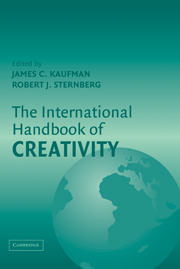Book contents
- Frontmatter
- Contents
- Acknowledgments
- List of Contributors
- 1 Introduction
- 2 Creativity Research in English-Speaking Countries
- 3 Creativity in Latin America
- 4 History of Creativity in Spain
- 5 Past, Present, and Future Perspectives on Creativity in France and French-Speaking Switzerland
- 6 Creativity in Italy
- 7 Creativity Research in German-Speaking Countries
- 8 Creativity Under the Northern Lights
- 9 Creativity in Soviet–Russian Psychology
- 10 Creativity Studies in Poland
- 11 Research on Creativity in Israel
- 12 Creativity in Turkey and Turkish-Speaking Countries
- 13 Development of Creativity Research in Chinese Societies
- 14 Creativity – A Sudden Rising Star in Korea
- 15 Culture and Facets of Creativity
- 16 African Perspectives on Creativity
- 17 Creativity Around the World in 80 Ways … but with One Destination
- Author Index
- Subject Index
- References
3 - Creativity in Latin America
Views from Psychology, Humanities, and the Arts
Published online by Cambridge University Press: 05 June 2012
- Frontmatter
- Contents
- Acknowledgments
- List of Contributors
- 1 Introduction
- 2 Creativity Research in English-Speaking Countries
- 3 Creativity in Latin America
- 4 History of Creativity in Spain
- 5 Past, Present, and Future Perspectives on Creativity in France and French-Speaking Switzerland
- 6 Creativity in Italy
- 7 Creativity Research in German-Speaking Countries
- 8 Creativity Under the Northern Lights
- 9 Creativity in Soviet–Russian Psychology
- 10 Creativity Studies in Poland
- 11 Research on Creativity in Israel
- 12 Creativity in Turkey and Turkish-Speaking Countries
- 13 Development of Creativity Research in Chinese Societies
- 14 Creativity – A Sudden Rising Star in Korea
- 15 Culture and Facets of Creativity
- 16 African Perspectives on Creativity
- 17 Creativity Around the World in 80 Ways … but with One Destination
- Author Index
- Subject Index
- References
Summary
INTRODUCTION
The purpose of this chapter is to discuss how creativity is viewed and practiced in Latin America and the Caribbean. Creativity is a multifaceted phenomenon, so several perspectives should be taken into consideration. We have chosen to focus on two. First, we review how psychologists in the region have studied creativity. Most such contributions have regarded creativity from an applied perspective, with an emphasis on its modification. However, this work is not sufficiently informative regarding what is culturally specific about creativity in the region. So, after discussing the scientific work on creativity, we found it necessary to summarize some of the views about creativity held by creative minds in the region, specifically artists and writers. These innovators not only provide a firsthand account of creativity in Latin America and the Caribbean but also put their creative work in a sociocultural perspective; this is an emphasis that we deem very relevant in a region as diverse as this one. It is worth noting that, whereas the work of psychologists has remained within specialized circles, the literary and artistic production of Latin American and Caribbean artists has reached large audiences. Thus, to the extent possible, we intend to make a more or less exhaustive review of the work of the former to provide an account that is instrumental for other researchers in the field.
- Type
- Chapter
- Information
- The International Handbook of Creativity , pp. 39 - 67Publisher: Cambridge University PressPrint publication year: 2006
References
- 3
- Cited by



